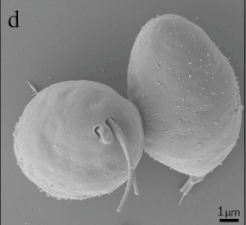Diplonema (excavate)
Diplonema is a genus of free living organisms in the Euglenozoa. They are distinguished from Rhynchopus in Class Diplonemea by the absence of a fully flagellate dispersive stage.
| Diplonema | |
|---|---|
 | |
| Scanning electron micrograph of Diplonema papillatum | |
| Scientific classification | |
| Domain: | |
| (unranked): | |
| Phylum: | |
| Class: | |
| Order: | |
| Family: | |
| Genus: | Diplonema Griessmann 1913 |
| Type species | |
| Diplonema breviciliata Griessman 1913 | |
| Species | |
| |
| Synonyms | |
| |
Characteristics
Diplonema feature two short flagella of equal length and two subapical openings. Most are free living, but there have been reported cases of infection in clams and sudden decomposition of aquarium plants. It was described initially in 1914 and later rediscovered in the 60s and called Isonema, wrongly classified among euglenids.[1][2]
gollark: Yes, thus technical problem.
gollark: Fully automated luxury gay space [TODO: ECONOMIC SYSTEM] when?
gollark: I mean, we still have to do *work* to attain *physical resources*.
gollark: This seems like more of a technical problem than a social one right now.
gollark: If my reward function and such are tweaked a ton, I may not consider the result "me".
References
- W. Marande, J. Lukeš y G. Burger, Unique Mitochondrial Genome Structure in Diplonemids, the Sister Group of Kinetoplastids, Eukaryot Cell. 2005 June; 4(6): 1137–1146.
- Brands, S.J. (comp.) 1989-2007. The Taxonomicon. Universal Taxonomic Services, Amsterdam, The Netherlands. , Fecha de acceso: 7 de Febrero del 2016.
This article is issued from Wikipedia. The text is licensed under Creative Commons - Attribution - Sharealike. Additional terms may apply for the media files.